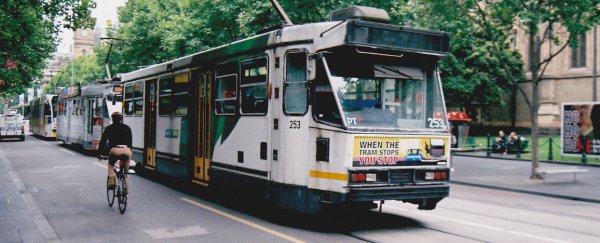A company has submitted a bold new proposal to Australia's Victorian state government, which would see Melbourne's iconic tram network run entirely solar power within the space of a few years.
According to the pitch, the public transport network would be run by energy generated at two new solar farms built near Swan Hill and Mildura, in the state's north-west. Together these proposed farms would be capable of generating the 80 gigawatt-hours of electricity a year needed to run the tram network, which is the largest in the world.
According to the Australian Solar Group - the company behind the bid - if approved, the plan would cut 100,000 tonnes of greenhouse gas emissions a year. Impressively, it also wouldn't increase the cost of public transport in the city.
"It was a condition given to us as part of the mission that we couldn't increase the cost of commuting," Dave Holland, a co-founder of the Australian Solar Group, told Sophie Vorrath from RenewEconomy. "We modelled historical contracted and future prices … and [the result of] this has been one of the driving forces behind the project."
The company has already invested AUD$3 million into the project, and has another AUD$70 million secured to build the solar farms, which they'll spend if the government-owned Public Transport Victoria commits to purchasing their energy for the next 20 years.
Relatively speaking, trams are already a pretty efficient form of public transport, but the fact that the electricity they require currently comes from burning coal means that they're still responsible for substantial emissions.
The alternative to this, the Australian Solar Group believes, is two 20 MW solar farms set on 80 hectare plots, which use 130,000 photovoltaic panels to track the Sun throughout the day.
Their proposed Swan Hill site already has full approval for the farm to be built, and the permits are underway for Mildura, according to Holland. "The first site is ready to go, we could literally start site works immediately… within the week," he told RenewEconomy. He predicts that construction would take around six months. Once up and running, the two solar farms would feed energy into the grid, which would offset the power demands from the tram network.
So what's the likelihood that Victoria's government will get behind the proposal? Tom Arup over at The Age reports that Transport Minister Terry Mulder sent a letter to the Melbourne city council last October saying that it was interested in the project as it fitted in with its environmental goals, but that the proposal had to be: "measured against the availability of brown coal and natural gas that for many years have given Victoria a relatively cheap source of energy".
Fingers crossed that the government sees the long-term cost, as well as the environmental benefits of having one of their main transport networks run entirely on solar power. Because this is the best idea we've heard in a long time.
